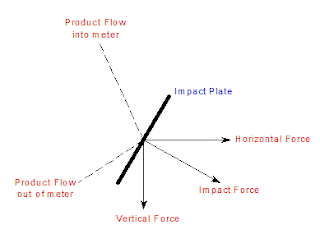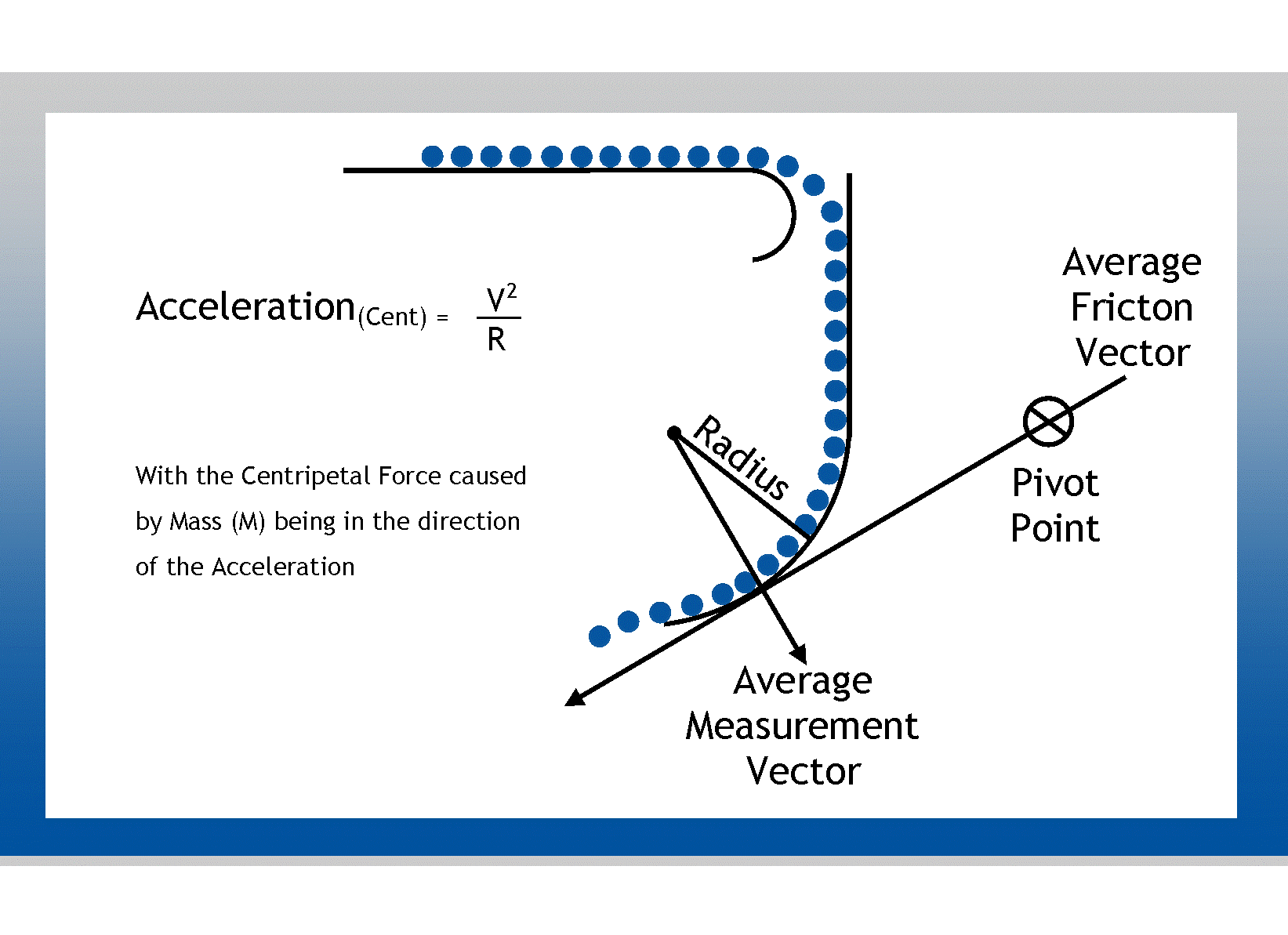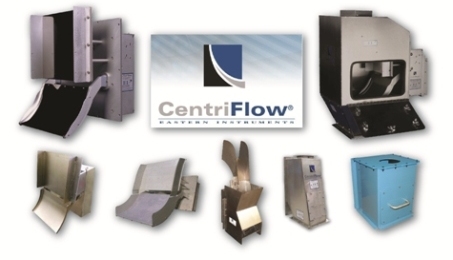Differences between the Impact Flow Meter and the Centripetal Force Flow Meter
There are a lot of solids flow meters on the market these days. But not all of these devices are the same, even though they may look the same. Many companies promote their devices as one thing, but underneath the hood they are really something else. So, how does a plant manager, process engineer, or maintenance manager tell the difference to pick the device they need to get the results they need? This blog will try to help clarify the difference between two of the most popular solids flow meters, the impact meter or impact flow meter and the centripetal force meter.
The Impact Flow Meter:
The impact flow meter goes by many different names like impact meter, impact scale, impact weigher or impact flow meter, but they are all basically the same. The measurement technique for an impact meter is fairly simple, product flow is dropped down a chute and directed to impact plate at a specific angle and flow rate.
The impact creates an impact force, which has a vertical and horizontal force associated to it. This impact force can be measured with a load cell or transducer that is located at the back of the device or under the plate. Another method for measuring this force is by using a sensor that eliminates the vertical component and only measures the horizontal component using a linear variable differential transformer or LVDT.
The output of the transducer or LVDT is then processed to provide a flow rate signal and integrated to provide a totalization signal. Some units are more sophisticated than others, using a microprocessor for the processing to provide some additional computations, filtering, and/or averaging.
The Centripetal Force Meter:
The centripetal force meter's measurement technique is simple as well, product flow is dropped vertically into the meter and directed into a curved measurement pan or chute.
The Impact Flow Meter:
The typical impact scale or impact flow meter provides an accuracy of measurement ranging from 0.5% to 5% depending on the complexity of the unit, product being measured, and configuration. The impact meter is very dependent on a repeatable flow stream to the unit. Because of this, many units will have a very long guide plate or chute to deliver the product to impact plate. For very free-flowing product, at a very consistent flow rate, the impact on the impact plate can be very repeatable, therefore getting 0.5%-1% accuracy. If the particle size varies very much or if the flow rate is highly variable, then the accuracy will degrade. Also, if the density varies or the elasticity of the product varies, then how the product contacts the impact plate will vary, again affecting the accuracy.
From a maintenance standpoint, unless the product is abrasive or dusty, the maintenance is pretty low on these types of devices. Wear on the impact plate and guide chute are usually the parts of the unit that need any attention. Caution should always be exercised if the units are plugged with product or if the unit is having maintenance performed to follow the manufacturers instructions to be sure that damage is not done to the transducer or LVDT sensor.
There are many different impact meters on the market so as you would expect you will get what you pay for when purchasing an impact meter. Some are highly robust, working in harsh environments and measuring high flows, while others are simplistic and are no more than sheet metal boxes around the impact plate. The robustness of the unit will also affect how accurate the measurement is as well as how long you can expect to get that accuracy.
The Centripetal Force Meter:
The centripetal force meter typically provides an accuracy of measurement ranging from 0.25% to 2% depending on the complexity of the unit, where the transducer is located, and configuration. The centripetal force meter's transducer location is critical, because it can be located where the friction force ends up being more of a force than the measurement force, making it highly affected by changes in particle size, density, and other product characteristics. How the product is presented into the meter's measurement pan or chute is also important since dropping it vertically and contacting the curve in the incorrect location will cause it to impact rather than slide, which goes against the basics of how it works to begin with.
From a maintenance standpoint, the centripetal force meter is similar to the impact meter in that they are pretty low maintenance. Wear on the curved measurement pan or chute or on any in-feed chute or deflector are usually the parts of the unit to be looked at. Handling of the transducer should always be done per the manufacturers instructions to be sure that it is not damaged when servicing the units.
The centripetal force meter usually is more robust than the typical impact meter, although there are some variations among them as well. Looking at the overall operating cost of any flow meter should not just include the price of the unit, but how it is designed/configured to hand the product, how it is mounted, what kind of maintenance costs can be expected.
Eastern Instruments provides a line of world class centripetal force meters with patented technology that stands out in the array of impact flow meters and centripetal force meters in the world today. And that technology can fit any product, any application, and any budget!
The CentriFlow Meter line from Eastern Instruments is designed with the transducer located in the back of the meter so it is separated from the process. The units have a Patented Friction Cancelling technology so that they are not affected by particle size variations, density variations, or pulsating flow streams. With the fastest response on the market, the CentriFlow Meters will provide a high speed output so that you will not miss any changes in your process. Manufactured of high strength aluminum and/or stainless steel, the CentriFlow Meters are designed to last way beyond the rest of the pack. For more details or to find the CentriFlow that is right for your application or project, check out the meter models below:
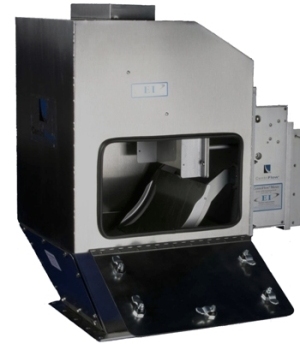 CentriFlow CFM Type I and Type II Meter:
CentriFlow CFM Type I and Type II Meter:
CentriFlow BWS Type II Meter:
CentriFlow Specialty Meters:
HOW THEY WORK
The Impact Flow Meter:
The impact flow meter goes by many different names like impact meter, impact scale, impact weigher or impact flow meter, but they are all basically the same. The measurement technique for an impact meter is fairly simple, product flow is dropped down a chute and directed to impact plate at a specific angle and flow rate.
The impact creates an impact force, which has a vertical and horizontal force associated to it. This impact force can be measured with a load cell or transducer that is located at the back of the device or under the plate. Another method for measuring this force is by using a sensor that eliminates the vertical component and only measures the horizontal component using a linear variable differential transformer or LVDT.
The output of the transducer or LVDT is then processed to provide a flow rate signal and integrated to provide a totalization signal. Some units are more sophisticated than others, using a microprocessor for the processing to provide some additional computations, filtering, and/or averaging.
The Centripetal Force Meter:
The centripetal force meter's measurement technique is simple as well, product flow is dropped vertically into the meter and directed into a curved measurement pan or chute.
The product slides through the curved measurement pan or chute rather than impacting it, creating a measurement force and friction force. The force is measured with a load cell or transducer that is located under the pan, behind the pan, or slightly above the pan. The location of the transducer makes a tremendous difference on how the centripetal force meter works.
The output of the transducer is then processed to provide a flow rate signal and integrated to provide a totalization signal. Here again, some units are more sophisticated than others, using a microprocessor for the processing to provide some additional computations, filtering, and/or averaging.
ACCURACY, MAINTENANCE, and ROBUSTNESS
The Impact Flow Meter:
The typical impact scale or impact flow meter provides an accuracy of measurement ranging from 0.5% to 5% depending on the complexity of the unit, product being measured, and configuration. The impact meter is very dependent on a repeatable flow stream to the unit. Because of this, many units will have a very long guide plate or chute to deliver the product to impact plate. For very free-flowing product, at a very consistent flow rate, the impact on the impact plate can be very repeatable, therefore getting 0.5%-1% accuracy. If the particle size varies very much or if the flow rate is highly variable, then the accuracy will degrade. Also, if the density varies or the elasticity of the product varies, then how the product contacts the impact plate will vary, again affecting the accuracy.
From a maintenance standpoint, unless the product is abrasive or dusty, the maintenance is pretty low on these types of devices. Wear on the impact plate and guide chute are usually the parts of the unit that need any attention. Caution should always be exercised if the units are plugged with product or if the unit is having maintenance performed to follow the manufacturers instructions to be sure that damage is not done to the transducer or LVDT sensor.
There are many different impact meters on the market so as you would expect you will get what you pay for when purchasing an impact meter. Some are highly robust, working in harsh environments and measuring high flows, while others are simplistic and are no more than sheet metal boxes around the impact plate. The robustness of the unit will also affect how accurate the measurement is as well as how long you can expect to get that accuracy.
The Centripetal Force Meter:
The centripetal force meter typically provides an accuracy of measurement ranging from 0.25% to 2% depending on the complexity of the unit, where the transducer is located, and configuration. The centripetal force meter's transducer location is critical, because it can be located where the friction force ends up being more of a force than the measurement force, making it highly affected by changes in particle size, density, and other product characteristics. How the product is presented into the meter's measurement pan or chute is also important since dropping it vertically and contacting the curve in the incorrect location will cause it to impact rather than slide, which goes against the basics of how it works to begin with.
From a maintenance standpoint, the centripetal force meter is similar to the impact meter in that they are pretty low maintenance. Wear on the curved measurement pan or chute or on any in-feed chute or deflector are usually the parts of the unit to be looked at. Handling of the transducer should always be done per the manufacturers instructions to be sure that it is not damaged when servicing the units.
The centripetal force meter usually is more robust than the typical impact meter, although there are some variations among them as well. Looking at the overall operating cost of any flow meter should not just include the price of the unit, but how it is designed/configured to hand the product, how it is mounted, what kind of maintenance costs can be expected.
NOT ALL METERS ARE CREATED EQUAL....
When it comes to both the impact flow meter and the centripetal force flow meter, there are a lot of choices and variations. They will all give you a flow measurement and totalization, however, how accurate you need it to be and how much your budget can afford will most likely direct you to one or another.Eastern Instruments provides a line of world class centripetal force meters with patented technology that stands out in the array of impact flow meters and centripetal force meters in the world today. And that technology can fit any product, any application, and any budget!
The CentriFlow Meter line from Eastern Instruments is designed with the transducer located in the back of the meter so it is separated from the process. The units have a Patented Friction Cancelling technology so that they are not affected by particle size variations, density variations, or pulsating flow streams. With the fastest response on the market, the CentriFlow Meters will provide a high speed output so that you will not miss any changes in your process. Manufactured of high strength aluminum and/or stainless steel, the CentriFlow Meters are designed to last way beyond the rest of the pack. For more details or to find the CentriFlow that is right for your application or project, check out the meter models below:
The CentriFlow Centripetal Force Flow Meter for Solid Mass Flow Measurement
 CentriFlow CFM Type I and Type II Meter:
CentriFlow CFM Type I and Type II Meter:- Typical Accuracy of 0.25%-0.50% for free-flowing products
- Typical Accuracy of 0.5%-1% for powder products
- Flow Surfaces customized based on product
- Aluminum and 304 Stainless Steel Exterior Construction
- Vertical Installation (Type II) for installations under feed devices like slide gates, rotary valves, bucket conveyors, screw conveyors, cyclone separators, screeners, air slides, or other gravity type feed devices
- Horizontal Installation (Type I) for installation after a belt conveyor, vibratory conveyor, or other horizontal feed devices
- Remote Electronics with standard 4-20mA flow output and totalization
- Communications Protocols for Ethernet/IP, DeviceNet, and Profibus available
- Options for Pulsed Air, VibraWeigh (vibration of measurement pan), and others for hard to deal with products
- Price competitively to Weigh Belt Feeders, Solids Coriolis Meters, and High Accuracy Impact Meters and Centripetal Force Meters
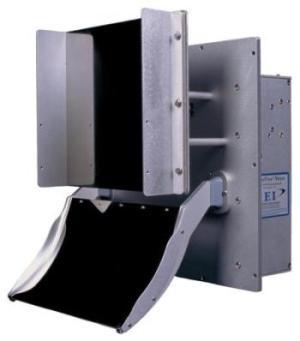
CentriFlow BWS Type II Meter:
- Typical Accuracy of 1%-2% for free-flowing products
- Flow Surface options include carbon steel, stainless steel, and ceramic tile for high wear applications
- Powder Coat Painted Carbon Steel Exterior Construction
- Vertical Installation (Type II) for installations under feed devices like slide gates, rotary valves, bucket conveyors, screw conveyors, cyclone separators, screeners, air slides, or other gravity type feed devices
- Integrated Electronics with standard 4-20mA flow output and totalization
- Price competitively with Standard Impact Meters and Centripetal Force Meters
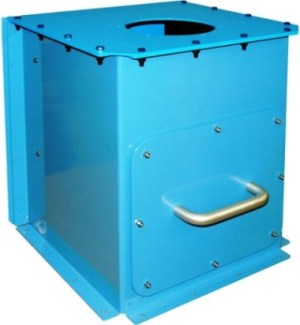
- CentriFlow HDM Meter for High Density and High Flow Rates
- CentriFlow LDM Meter for Light, Bulky, Large products
- CentriFlow CFL Meter for flow rates under 5,000 lb/hr or 2,200 kg/hr
For more information on the CentriFlow Centripetal Force Meters please visit our website easterninstruments.com, call us at 910-392-2490, or send us an email at sales@easterninstruments.com today!
